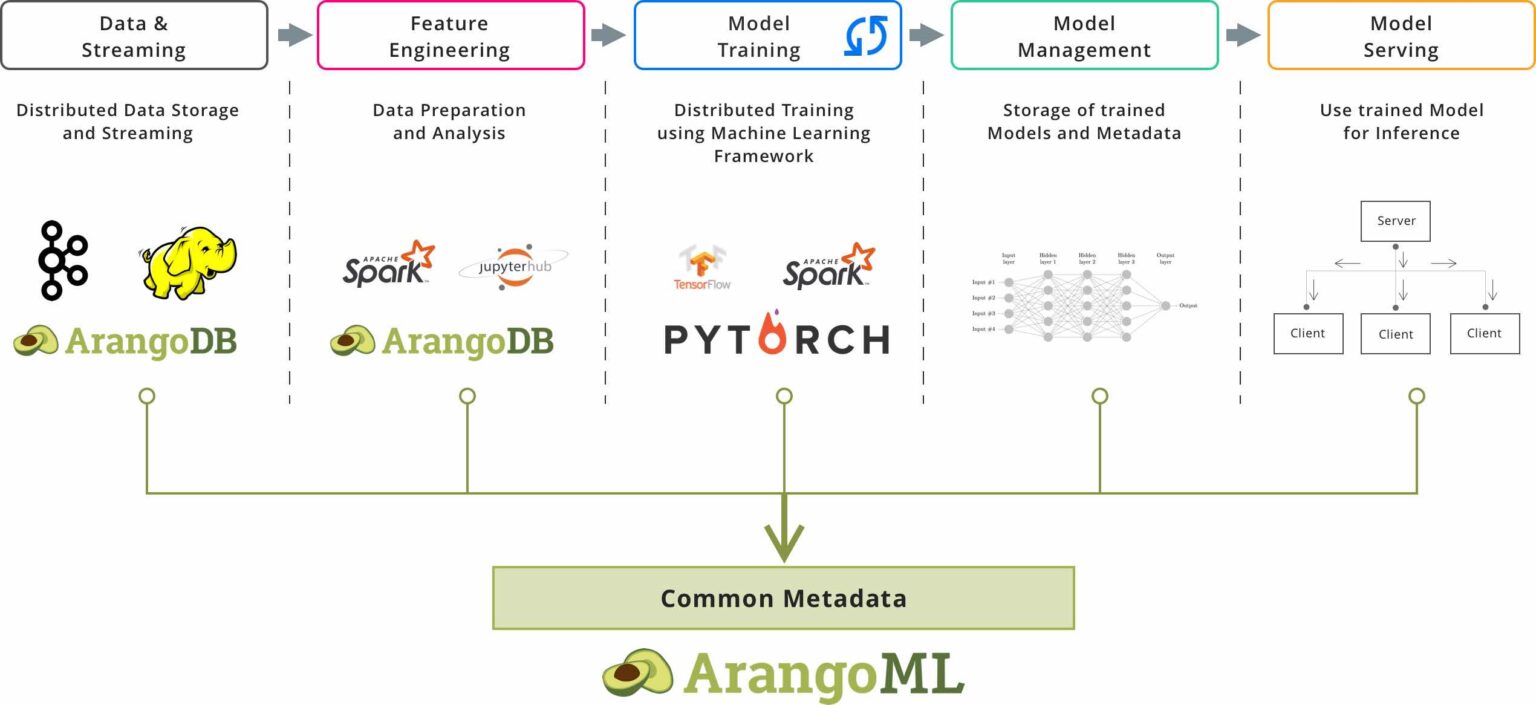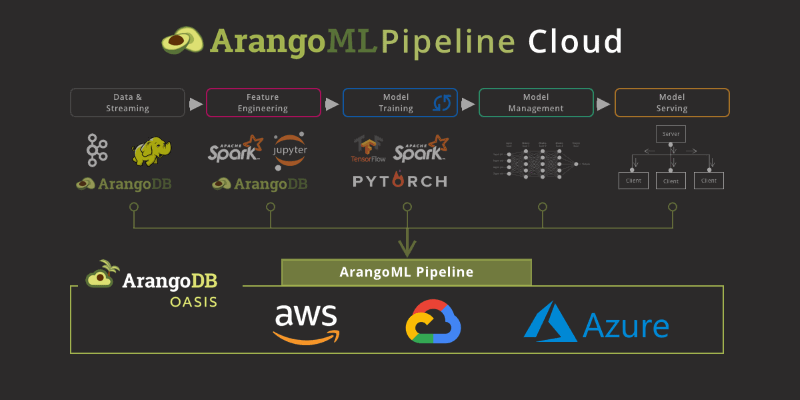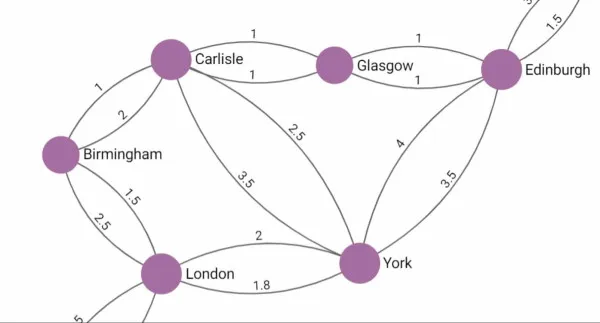ArangoML Series: Multi-Model Collaboration
Estimated reading time: 8 minutes
Multi-Model Machine Learning
This article looks at how a team collaborating on a real-world machine learning project benefits from using a multi-model database for capturing ML meta-data.
The specific points discussed in this article are how:
- The graph data model is superior to relational for ML meta-data storage.
- Storing ML experiment objects is natural with multi-model.
- ArangoML promotes collaboration due to the flexibility of multi-model.
- ArangoML provides ops logging and performance analysis.

ArangoML Series: Intro to NetworkX Adapter
Estimated reading time: 3 minutes
This post is the fifth in a series of posts introducing the ArangoML features and tools. This post introduces the NetworkX adapter, which makes it easy to analyze your graphs stored in ArangoDB with NetworkX.
In this post we:
- Briefly introduce NetworkX
- Explore the IMDB user rating dataset
- Showcase the ArangoDB integration of NetworkX
- Explore the centrality measures of the data using NetworkX
- Store the experiment with arangopipe
This notebook is just a slice of the full-sized notebook available in the ArangoDB NetworkX adapter repository. It is summarized here to better fit the blog post format and provide a quick introduction to using the NetworkX adapter.

Neo4j Fabric: Scaling out is not only distributing data
Estimated reading time: 3 minutes
Neo4j, Inc. is the well-known vendor of the Neo4j Graph Database, which solely supports the property graph model with graphs of previously limited size (single server, replicated).
In early 2020, Neo4j finally released its 4.0 version which promises “unlimited scalability” by the new feature Neo4j Fabric. While the marketing claim of “scalability” is true seen from a very simplistic perspective, developers and their teams should keep a few things in mind – most importantly: True horizontal scalability with graph data is not achieved by just allowing distributing data to different machines. Read more
ArangoDB 3.5 Released: Distributed Joins & Transactions
We are super excited to share the latest upgrades to ArangoDB which are now available with ArangoDB 3.5. With the fast-growing team, we could build many new and long-awaited features in the open-source edition and Enterprise Edition. Get ArangoDB 3.5 on our download page and see all changes in the Changelog.
Need to know more about multi-model?
Maybe good to know: Our Cloud Service offering, ArangoDB ArangoGraph, will run the full Enterprise Edition of ArangoDB 3.5 including all security as well as special features. You can find more about ArangoDB ArangoGraph and play around for 14-days free in the cloud.
Join the upcoming ArangoDB 3.5 Feature Overview Webinar to have a detailed walkthrough on the release with our Head of Engineering and Machine Learning, Jörg Schad.
tl;dr Highlights of ArangoDB 3.5
- SmartJoins which enable you to run efficient co-located JOIN operations against distributed data (Enterprise Edition)
- The long awaited Streaming Transactions API which lets you run & manage ACID transactions directly from your driver (Java Sync, Go, JavaScript & PHP already supported)
- ArangoSearch improvements including configurable analyzers, lightning fast sorted indexes and other goodies
- Extended graph database capabilities like k-shortest path and the new PRUNE keyword
- Data Masking lets you work securely with obfuscated production data for real-world development & testing environments (Enhanced Data Masking available in Enterprise)
- Helpful updates like Time-To-Live Indexes, Index Hints and Named Indexes
- And a little late to the party… Lightning fast consistent Cluster Backups (following with 3.5.1/ Enterprise-only)
Keen to learn more? Let’s take a closer look at the new features.
SmartJoins - Co-located JOINs in a NoSQL Database
There are many operational and analytical use cases where sharding two large collections is needed, and fast JOIN operations between these collections is an important requirement.
In close teamwork with some of our largest customers, we developed SmartJoins (available in ArangoDB Enterprise only). This new feature allows to shard large collections to a cluster in a way that keeps data to be joined on the same machines. This smart sharding technique allows co-located JOIN operation in ArangoDB many might know from RDBMS but now available in a multi-model NoSQL database.
While our first offering of distributed JOIN operations, SatelliteCollections, allows for sharding one large collection and replicating many smaller ones for local joining, SmartJoins allow two large collections to be sharded to an ArangoDB cluster, with JOIN operations executed locally on the DBservers. This minimizes network latency during query execution and provides the performance close to a single instance for analytical and operational workloads.
For example, let’s assume we have two large collections, e.g. `Products` and `Orders`, which have a one-to-many relationship as each product can appear in any order. You can now use e.g. the `productId` during the creation of the collection to shard the two collections alike (see arangosh example below):
db._create("products", { numberOfShards: 3, shardKeys: ["_key"] });
db._create("orders", { distributeShardsLike: "products", shardKeys: ["productId"] });When querying both collections with your normal join query in AQL, the query engine will automatically recognize that you sharded the data in a SmartJoin-fashion and only send the query to the relevant DB-servers for local query execution. Network overhead is thereby reduced to an absolute minimum.
For more details you can either check out the SmartJoins tutorial or watch the walk through below showing off some first performance indications and how to even combine SmartJoins with SatelliteCollections:
Streaming Transactions API - Execute & Control ACID Transactions From Your Language Driver
ArangoDB supported ACID transactions basically from the very beginning, either via AQL operations or by writing transactions in JavaScript. The new streaming transactions API now allows users to BEGIN, COMMIT or ABORT (rollback) operations from all supported drivers (i.e., Java Sync, GO, JavaScript, PHP).
With the streaming transaction API, a transaction can consist of a series of transactional operations and therefore allows clients to construct larger transactions in a much more efficient way than the previous JavaScript-based solution. You can also leverage various configurations for your transactions to meet your individual needs, like:
- Collections: The collections the transaction will need for any write operation
- waitForSync: An optional boolean flag to force the transaction to write to disk before returning
- allowImplicit: Allows the transaction to read from undeclared collections
- lockTimeout: Lets you specify the maximum time for the transaction to be completed (default is 10 minutes)
- maxTransactionSize: If you are using RocksDB as your storage engine (default engine since ArangoDB 3.4), you can define the maximal size of your transaction in bytes
For more details, please see the documentation for Streaming Transactions. If you are maintaining an ArangoDB driver, please see the RC blogpost for details around integrating the new API into your driver.
Please note: Streaming transactions come with full ACID guarantees on a single instance and provide also a better transactional experience in a cluster setting. ArangoDB does not support distributed ACID transactions -- yet.
Search Engine Upgrades - Configurable Analyzers and Lightning-Fast Sorted Queries
Frankly, we are absolutely thrilled about how many people embrace ArangoSearch and build amazing applications with it. Having a fully integrated C++ based search & ranking engine within a multi-model database seems to come in very handy for many people out there. New to ArangoSearch? Check out the tutorial
We enlarged the ArangoSearch team and can now release two huge improvements to the search capabilities of ArangoDB: Configurable Analyzers & Super Fast Sorted Queries.
Configurable Analyzers let you perform case-sensitive searches, word stemming and also let you use your own language-specific stopword lists. They also let you fine-tune your ArangoSearch queries even better for a broad variety of languages, including English, French, German, Chinese and many more. Check out the tutorial on how to work with Configurable Analyzers in ArangoDB.
Queries including sorting will see a real performance boost in ArangoDB 3.5 when using the new sorted indexes. When creating a `view` for ArangoSearch you can now specify the creation of this new index and define which sort order is best for your queries (asc/dec). If the sort order in your query matches the one specified in your view, results can be directly read from the index and returned super fast. Internal benchmarks show a performance improvement of up to 1500x for these situations.
Creating a sorted view can be done via `arangosh`
db._createView('myView', 'arangosearch', { links : { ... }, primarySort: [ { field: 'myField', direction: 'asc' }, { field: 'anotherField', direction: 'desc' } ] })
db._query('FOR d in myView SEARCH ... SORT d.myField ASC RETURN d`); // no sorting at query time
For more details on Sorted Views & ArangoSearch, check out the video tutorial below:
Additional Upgrades to ArangoSearch
Besides the new key features of ArangoSearch, you can now access and also use the relevance scores calculated by the BM25 or TFIDF algorithms directly in queries to e.g. limit searches to only include results meeting a minimum relevancy to your query.
Restricting search queries to specific collections can provide performance benefits for your queries. If your ArangoSearch `view` spans multiple collections, you can now limit your search queries to specific collections which you can define within your search queries. This can provide a significant performance boost, as less data has to be accessed.
For more details, please see the blog post for ArangoSearch Updates.
Graph Database Upgrades - k-shortest path and new PRUNE keyword
As one of the leading graph databases out there, ArangoDB already provides a rich feature set ranging from simple graph traversals to complex distributed graph processing.
New to graphs?
The new k-shortest path feature adds to this featureset and provides the option to query for all shortest paths between two given vertices, returning sorted results based on path length or path weight. Imagine you transferred a transportation network to a graph dataset and now navigate between two given points. With k-shortest path, you can query for shortest travel distance, shortest travel time, least amount of road fees or any other information you have stored on edges.

In the example of the European railroad connections above, we could e.g. query for the shortest distance, least stops or cheapest fare for traveling between London and Glasgow depending on the information you have stored at your edges. You can also think of various network management use cases or threat intelligence for applying the new k-shortest path feature.
If you’d like to dive a bit deeper into k-shortest paths, you can watch the video tutorial or get hands-on with the tutorial in our training center.
The new PRUNE keyword is an alternative for FILTERs in AQL graph traversal queries. Using PRUNE allows users to reduce the amount of documents the traversal query has to look up. PRUNE acts like a stop condition within graph traversals, telling the traversal to stop when a given criteria is met and return the full result path.
In contrast to pure FILTER queries, which first lookup all potential results and then apply the filter condition on all results found, PRUNE directly applies the filter condition directly to each vertex. Queries using PRUNE can, therefore, reduce the amount of total lookups needed and speed up queries significantly. By using PRUNE, internal tests show a performance gain by several orders of magnitude in some use cases. See one of these cases yourself in the video tutorial below:
Data Masking – For GDPR and CCPA-compliant Testing & Development
Testing new versions of a production environment or developing new features is best when you do so as close to production as possible. But, exporting sensitive data like names, birthdays, email addresses or credit card information from highly-secure production systems to be used in lower-security testing and development environments is often not possible -- or poses GDPR / CCPA compliance issues. Data Masking to the rescue!
The new Data Masking feature in ArangoDB lets you define sensible data to be obfuscated, then generates masked exports of these collections to be used for testing or development purposes.
The open-source edition of ArangoDB supports already a simple version of Data Masking, letting you obfuscate arbitrary data with random strings which can already be quite helpful.
But the Enterprise Edition of ArangoDB takes things a few steps further and lets you preserve the structure of the data while obfuscating it. Birthdays, credit card numbers, email addresses or other sensitive data can be defined and obfuscated in a way that preserves the structure for testing experiences as close to production as possible. Try Data Masking yourself with this tutorial.
Hot Backups – Little late to the Party (coming with 3.5.1)
Creating consistent snapshots across a distributed environment is a challenging problem.
With hot backups in the Enterprise Edition, you can create automatic, consistent backups of your ArangoDB cluster without noticeable impact on your production systems. In contrast to Arangodump, hot backups are taken on the level of the underlying storage engine and hence both backup and restore are considerably faster.
Hot backups will be available in the Enterprise Edition. Stay tuned for more details.
Neat and helpful upgrades
In addition to the new features outlined above, ArangoDB 3.5 also includes smaller improvements that add to a nice and easier experience with ArangoDB.
Sort-Limit Optimization in AQL is for specific use cases to speed up queries where it is not possible to use an index to sort the results. You can check out the tutorial with performance gain indications on our blog.
Time-to-Live Indexes allow you to automatically remove documents after a certain period of time or at a specific date. This can be useful for e.g. automatically removing session data or also with GDPR rules like “The right to be forgotten”. Check out the TTL tutorial for more details.
Index Hints allow users to provide the query optimizer with a hint that a certain index should be used. The query optimizer will then take a closer look at the index hinted. Users can also enforce the usage of a specific index. Find more details in this brief tutorial.
When using many indexes within a collection it can come in handy to name them. With Named Indexes users can now specify a name for an index to make navigating through indexes much easier. Learn how to use named indexes in this tutorial.
Of course, there are dozens of other optimizations under the hood, including performance tuning, cluster improvements and much more. Take ArangoDB 3.5 for a test drive and see for yourself. Any feedback is, as always, highly appreciated! If you are upgrading from a previous version, check our General Upgrade Guide.
Did these new features get you excited and you are curious whats next for ArangoDB? Join the “ArangoDB 3.6: The Future is Full of Features” webinar with our Head of Engineering & Machine Learning Joerg Schad.
We hope you find many useful new features and improvements in ArangoDB 3.5. If you like to join the ArangoDB Community, you can do so on GitHub, Stack Overflow and Slack.
ArangoDB 3.5 RC1: Graph Database Improvements
After a lot of planning, coding and testing we can finally share the first Release Candidate of ArangoDB 3.5 with you today. You can get it on our Technical Preview Download page: Community & Enterprise.
With this RC, we want to highlight two new features for all graph database enthusiasts: the new PRUNE Keyword & k Shortest Path Feature. As always, please note Release Candidates are for testing purposes only and should not be used in production. Please see limitations of RC1 at the bottom of the page! Read more
What Makes ArangoDB a Graph Database?
When looking for a solution for your project, it is important to understand what makes each technology unique, what sets it apart. With ArangoDB that is its native multi-model approach including full graph database capabilities and I am going to explain the fundamental pieces of what that means. Read more
Time traveling with graph databases
Graph databases are often used to analyze relations within highly interconnected datasets. Social networks, recommendation engines, corporate hierarchies, fraud detection or querying a bill of materials are common use cases. But these datasets change over time and you as a developer or data scientist may want to time travel and analyze these changes.
While ArangoDB may not come with built-in support for managing the revision history of graph data, we’ll show in this article how to manage it in a performant manner for some general classes of graphs. Best of all, this won’t require any groundbreaking new ideas. We’ll simply borrow a few tools and tricks from the persistent data structure literature and adapt them for good performance within ArangoDB. We hope that this will help enable new ways to use everyone’s favorite avocado-fueled datastore, and power some useful applications. Read more
ArangoDB Named Best Free Graph Database by G2 Crowd Users
ArangoDB named by G2 Crowd users as the most popular graph database used today.
ArangoDB has been identified as the highest rated graph database, based on its high levels of customer satisfaction and likeliness to recommend ratings from real G2 Crowd users.
ArangoDB received a near perfect 4.9 out of 5 star average for user satisfaction for its free platform across its 24 user reviews. ArangoDB users point to the database’s query language, availability and storage as the three most liked features of the product. Read more
ArangoDB | Infocamere Investigation: Graph Databases Case Study
InfoCamere is the IT company of the Italian Chambers of Commerce. By devising and developing up-to-date and innovative IT solutions and services, it connects the Chambers of Commerce and their databases through a network that is also accessible to the public via the Internet. Thanks to InfoCamere, businesses, Public Authorities, trade associations, professional bodies and simple citizens – both in Italy and abroad – can easily access updated and official information and economic data on all businesses registered and operating in Italy.
The Italian Chambers of Commerce are public bodies entrusted to serve and promote Italian businesses through over 300 branch offices located throughout the country. InfoCamere helps them in pursuing their goals in the interest of the business community. On behalf of the Chambers’ System, InfoCamere plays a key-role in implementing the Italian Digital Agenda with respect to the digital transformation process of the national productive system, especially focusing on supporting the digitalization of SMEs.
Guest post by Luca Sinico (Software Developer, InfoCamere)
ArangoDB Webinar: Apps with ArangoDB & KeyLines
Wednesday, September 6th (5PM CEST/11AM ET/8AM PT) – Join the webinar here
 As data gets bigger, faster and more complex, you need to arm yourself with the best tools. In this webinar we’ll see how KeyLines and ArangoDB combine to create powerful and intuitive data analysis platforms. Read more
As data gets bigger, faster and more complex, you need to arm yourself with the best tools. In this webinar we’ll see how KeyLines and ArangoDB combine to create powerful and intuitive data analysis platforms. Read more
- « Previous
- 1
- 2
- 3
- 4
- Next »
Get the latest tutorials,
blog posts and news:
Thanks for subscribing! Please check your email for further instructions.
 Skip to content
Skip to content 